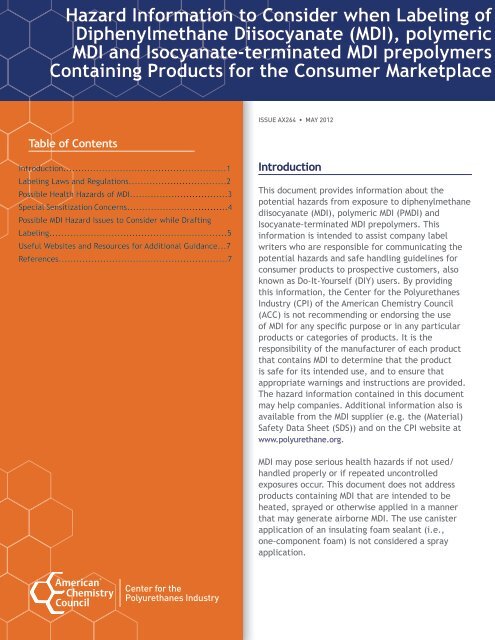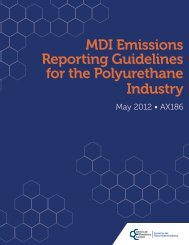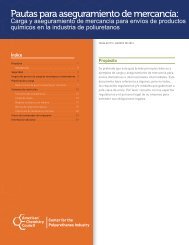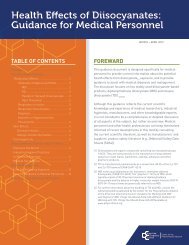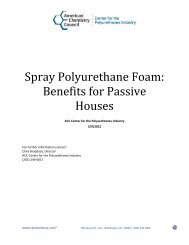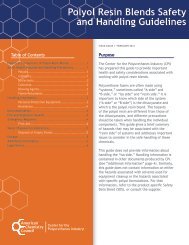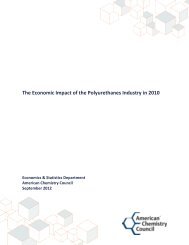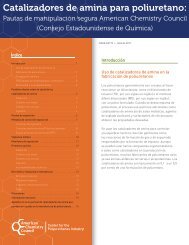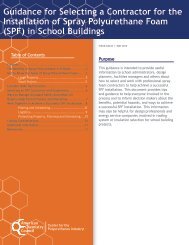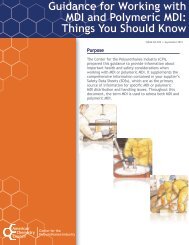Hazard Information to Consider when Labeling of Diphenylmethane ...
Hazard Information to Consider when Labeling of Diphenylmethane ...
Hazard Information to Consider when Labeling of Diphenylmethane ...
You also want an ePaper? Increase the reach of your titles
YUMPU automatically turns print PDFs into web optimized ePapers that Google loves.
<strong>Hazard</strong> <strong>Information</strong> <strong>to</strong> <strong>Consider</strong> <strong>when</strong> <strong>Labeling</strong> <strong>of</strong><br />
<strong>Diphenylmethane</strong> Diisocyanate (MDI), polymeric<br />
MDI and Isocyanate-terminated MDI prepolymers<br />
Containing Products for the Consumer Marketplace<br />
Table <strong>of</strong> Contents<br />
Introduction.......................................................1<br />
<strong>Labeling</strong> Laws and Regulations.................................2<br />
Possible Health <strong>Hazard</strong>s <strong>of</strong> MDI.................................3<br />
Special Sensitization Concerns..................................4<br />
Possible MDI <strong>Hazard</strong> Issues <strong>to</strong> <strong>Consider</strong> while Drafting<br />
<strong>Labeling</strong>............................................................5<br />
Useful Websites and Resources for Additional Guidance...7<br />
References.........................................................7<br />
ISSUE AX264 • MAY 2012<br />
Introduction<br />
This document provides information about the<br />
potential hazards from exposure <strong>to</strong> diphenylmethane<br />
diisocyanate (MDI), polymeric MDI (PMDI) and<br />
Isocyanate-terminated MDI prepolymers. This<br />
information is intended <strong>to</strong> assist company label<br />
writers who are responsible for communicating the<br />
potential hazards and safe handling guidelines for<br />
consumer products <strong>to</strong> prospective cus<strong>to</strong>mers, also<br />
known as Do-It-Yourself (DIY) users. By providing<br />
this information, the Center for the Polyurethanes<br />
Industry (CPI) <strong>of</strong> the American Chemistry Council<br />
(ACC) is not recommending or endorsing the use<br />
<strong>of</strong> MDI for any specific purpose or in any particular<br />
products or categories <strong>of</strong> products. It is the<br />
responsibility <strong>of</strong> the manufacturer <strong>of</strong> each product<br />
that contains MDI <strong>to</strong> determine that the product<br />
is safe for its intended use, and <strong>to</strong> ensure that<br />
appropriate warnings and instructions are provided.<br />
The hazard information contained in this document<br />
may help companies. Additional information also is<br />
available from the MDI supplier (e.g. the (Material)<br />
Safety Data Sheet (SDS)) and on the CPI website at<br />
www.polyurethane.org.<br />
MDI may pose serious health hazards if not used/<br />
handled properly or if repeated uncontrolled<br />
exposures occur. This document does not address<br />
products containing MDI that are intended <strong>to</strong> be<br />
heated, sprayed or otherwise applied in a manner<br />
that may generate airborne MDI. The use canister<br />
application <strong>of</strong> an insulating foam sealant (i.e.,<br />
one-component foam) is not considered a spray<br />
application.
<strong>Hazard</strong> <strong>Information</strong> <strong>to</strong> <strong>Consider</strong> <strong>when</strong> <strong>Labeling</strong> <strong>of</strong> <strong>Diphenylmethane</strong> Diisocyanate (MDI), polymeric MDI and<br />
Isocyanate-terminated MDI prepolymers Containing Products for the Consumer Marketplace<br />
<strong>Labeling</strong> Laws and Regulations<br />
This document only addresses MDI, polymeric MDI and isocyanate-terminated MDI prepolymers.<br />
Under applicable laws, labels for certain hazardous substances must address the hazards <strong>of</strong> the product<br />
itself, including any synergistic or antagonistic effects among the mixture ingredients, not just the<br />
hazards <strong>of</strong> the individual components. Thus, producers <strong>of</strong> MDI-containing products must consider the<br />
hazards <strong>of</strong> the product as a whole, including all its ingredients and not just the hazards <strong>of</strong> MDI by itself.<br />
The vast majority <strong>of</strong> MDI uses are for industrial applications. <strong>Hazard</strong> communication training,<br />
medical surveillance, training in proper handling precautions and use <strong>of</strong> personal protective equipment<br />
(PPE) are generally provided consistent with legal requirements and safe handling practices.<br />
However, there are some MDI-containing products available <strong>to</strong> the general public, for purchase at<br />
retail s<strong>to</strong>res or on-line, which can be used in DIY applications. Consumers using these products need <strong>to</strong><br />
understand and follow appropriate safe handling practices, which may include use <strong>of</strong> Personal Protective<br />
Equipment (PPE). End-use product labels are one means <strong>of</strong> communicating this information <strong>to</strong> the DIY<br />
user and may be required under applicable laws and U.S. Consumer Product Safety Commission (CPSC)<br />
regulations.<br />
Products that are hazardous and available for consumers <strong>to</strong> purchase or use are subject <strong>to</strong> the<br />
labeling requirements <strong>of</strong> the Federal <strong>Hazard</strong>ous Substances Act (FHSA) (15 U.S.C. Section 1261), which is<br />
administered by the CPSC. These requirements are manda<strong>to</strong>ry, and failure <strong>to</strong> comply with them can<br />
result in civil and/or criminal penalties. These regulations are found in the Code <strong>of</strong> Federal Regulations<br />
at 16 C.F.R. Part 1500. The current regulations specify that a label must conspicuously state, among<br />
other information:<br />
1. The common or usual or chemical name <strong>of</strong> the hazardous ingredient(s);<br />
2. The signal word “Danger” for products that are corrosive, extremely flammable, or highly <strong>to</strong>xic;<br />
3. The signal word “Caution” or “Warning” for all other hazardous products<br />
4. An affirmative statement <strong>of</strong> the principal hazard or hazards that the product presents, for<br />
example “Flammable”, “Harmful if Swallowed”, “Causes Burns”, “Vapor Harmful”, etc.;<br />
5. Precautionary statements telling users what they must do or what actions they must avoid <strong>to</strong><br />
protect themselves;<br />
6. Where it is appropriate, instructions for first aid treatment <strong>to</strong> perform in the event that the<br />
product injures someone;<br />
7. The word “Poison” for a product that is highly <strong>to</strong>xic, in addition <strong>to</strong> the signal word “Danger”;<br />
8. The name and business address <strong>of</strong> manufacturer, packager, distribu<strong>to</strong>r or seller; and<br />
9. The statement “Keep out <strong>of</strong> the reach <strong>of</strong> children”.<br />
Additionally, a label writer considers MDI and its characteristics in relationship <strong>to</strong> the quantity <strong>of</strong><br />
MDI in the product, likely exposure scenarios <strong>to</strong> MDI in the product, and the hazards posed by the product<br />
mixture, not just MDI, including any synergistic or antagonistic effects.<br />
2
<strong>Hazard</strong> <strong>Information</strong> <strong>to</strong> <strong>Consider</strong> <strong>when</strong> <strong>Labeling</strong> <strong>of</strong> <strong>Diphenylmethane</strong> Diisocyanate (MDI), polymeric MDI and<br />
Isocyanate-terminated MDI prepolymers Containing Products for the Consumer Marketplace<br />
The responsibility for proper labeling rests with the manufacturer or distribu<strong>to</strong>r making a<br />
hazardous product available for consumers; however, help in preparing labels is available from a number<br />
<strong>of</strong> sources. For example, 16 C.F.R. 1500.128 states that a manufacturer may obtain informal comments<br />
on proposed labeling involving hazardous substances. Further information on the CPSC can be found on<br />
their website. Additionally, several industry trade associations provide labeling guidance <strong>to</strong> their member<br />
companies. See the “Websites and Resources” section in this document for more information.<br />
Possible Health <strong>Hazard</strong>s <strong>of</strong> MDI<br />
An isocyanate is any chemical that contains at least one isocyanate functional group in its<br />
structure. An isocyanate group is one nitrogen a<strong>to</strong>m attached by a double bond <strong>to</strong> one carbon a<strong>to</strong>m that,<br />
in turn, is attached by a second double bond <strong>to</strong> an oxygen a<strong>to</strong>m (-N=C=O). A chemical containing two<br />
such groups is called a diisocyanate. MDI is one such diisocyanate. <strong>Diphenylmethane</strong> diisocyanate,<br />
commonly referred <strong>to</strong> as MDI, is a white <strong>to</strong> yellowish solid at room temperature with no odor. Polymeric<br />
MDI, which is more commonly used, is a mixture <strong>of</strong> MDI monomer and oligomers. It is a brownish liquid at<br />
room temperature and may have a slight odor. A third type <strong>of</strong> MDI product, known commonly as<br />
“modified MDIs,” are liquid at room temperature and are either colorless or slightly yellow.<br />
Contact with excessive amounts <strong>of</strong> MDI vapor, liquid or aerosol can be harmful <strong>to</strong> human health.<br />
When handling MDI, there are four routes <strong>of</strong> exposure <strong>to</strong> consider:<br />
• Inhalation,<br />
• Eye contact,<br />
• Skin contact, and<br />
• Ingestion/swallowing.<br />
Depending upon the concentration <strong>of</strong> MDI in the atmosphere, inhalation <strong>of</strong> airborne MDI may<br />
produce health effects such as irritation <strong>to</strong> the mucous membranes, the eyes, and the upper and lower<br />
respira<strong>to</strong>ry tracts.<br />
Inhalation <strong>of</strong> elevated levels <strong>of</strong> MDI also may result in the development <strong>of</strong> respira<strong>to</strong>ry<br />
sensitization.<br />
Exposures above occupational exposure limits(OELs) (see Table 1) may cause tearing and<br />
burning <strong>of</strong> the eyes, tightness <strong>of</strong> the chest, difficult or labored breathing, and more severe respira<strong>to</strong>ry<br />
effects, including chemical bronchitis, pneumonitis, sensitization and pulmonary edema. Effects may be<br />
immediate and/or delayed for hours after exposure. Symp<strong>to</strong>ms may increase or intensify for a few hours,<br />
but usually disappear within a day or two. However, both specific and non-specific bronchial<br />
responsiveness have in some cases persisted for months or even years. 1<br />
Exposure above workplace limits may lead <strong>to</strong> permanent pulmonary effects. Limited evidence<br />
from labora<strong>to</strong>ry animals indicates that skin contact with MDI may play a role in respira<strong>to</strong>ry sensitization.<br />
Sensitized individuals may experience severe asthma-like attacks <strong>when</strong>ever they are subsequently<br />
3
<strong>Hazard</strong> <strong>Information</strong> <strong>to</strong> <strong>Consider</strong> <strong>when</strong> <strong>Labeling</strong> <strong>of</strong> <strong>Diphenylmethane</strong> Diisocyanate (MDI), polymeric MDI and<br />
Isocyanate-terminated MDI prepolymers Containing Products for the Consumer Marketplace<br />
exposed <strong>to</strong> even minute amounts <strong>of</strong> airborne diisocyanates. Asthma attacks can be life-threatening. Once<br />
sensitized, these individuals must avoid further exposure <strong>to</strong> diisocyanates. 2<br />
Table 1—Airborne Concentrations Standards/Guidelines*<br />
OSHA<br />
ACGIH<br />
The Occupational Safety and Health Administration (OSHA) has set a Permissible<br />
Exposure Limit (Ceiling) [PEL(C)] for MDI in air <strong>of</strong> 20 parts per billion (ppb) (0.2<br />
mg/m 3 ).<br />
The American Conference <strong>of</strong> Governmental Industrial Hygienists (ACGIH) has adopted<br />
a Threshold Limit Value (TLV) <strong>of</strong> 5 ppb (0.051 mg/m 3 ) as an 8-hour Time Weighted<br />
Average (TWA).<br />
CPSC The Consumer Product Safety Commission has not established guidelines for MDI.<br />
* Please read the latest version <strong>of</strong> the standards/guidelines, which provided on the supplier’s safety data sheet<br />
(SDS), for updates.<br />
Repeated or prolonged skin contact with liquid MDI may discolor the skin and cause redness,<br />
irritation, or swelling. Skin contact with MDI may also produce allergic contact dermatitis. If MDI comes<br />
in<strong>to</strong> contact with the skin, the affected areas should be washed thoroughly with warm soapy water.<br />
Refer <strong>to</strong> the supplier SDS for specific recommendations.<br />
Special Sensitization Concerns<br />
1. Sensitization Reactions below Workplace Guidelines<br />
MDI is a known skin and respira<strong>to</strong>ry sensitizer. The ACGIH TLV for MDI is based, among other<br />
things, upon the potential for sensitization and is meant <strong>to</strong> protect workers from induction <strong>of</strong> this<br />
effect. However, there is no established level <strong>to</strong> which already sensitized individuals may be<br />
safely exposed. Therefore, previously sensitized individuals should avoid further exposure. 3<br />
2. Cross-Sensitization<br />
Because there is some evidence <strong>of</strong> cross-sensitization among diisocyanates, individuals who have<br />
become sensitized <strong>to</strong> other diisocyanates should avoid exposure <strong>to</strong> MDI. 4<br />
4
<strong>Hazard</strong> <strong>Information</strong> <strong>to</strong> <strong>Consider</strong> <strong>when</strong> <strong>Labeling</strong> <strong>of</strong> <strong>Diphenylmethane</strong> Diisocyanate (MDI), polymeric MDI and<br />
Isocyanate-terminated MDI prepolymers Containing Products for the Consumer Marketplace<br />
Possible MDI <strong>Hazard</strong> Issues <strong>to</strong> <strong>Consider</strong> while Drafting<br />
<strong>Labeling</strong><br />
The most likely possible hazard issues for MDI are:<br />
Heating MDI-containing products or using them in a manner that causes MDI <strong>to</strong> become airborne<br />
may increase the potential for exposure. Exposure <strong>to</strong> elevated levels <strong>of</strong> airborne MDI may result<br />
in the development <strong>of</strong> respira<strong>to</strong>ry sensitization.<br />
Skin contact with MDI can cause irritation. Skin contact with MDI also may result in dermal<br />
sensitization.<br />
Individuals already sensitized <strong>to</strong> MDI can have a skin or respira<strong>to</strong>ry reaction from exposures <strong>to</strong><br />
levels <strong>of</strong> diisocyanate below the OELs.<br />
Individuals already sensitized <strong>to</strong> another diisocyanate can have a skin or respira<strong>to</strong>ry reaction from<br />
exposures <strong>to</strong> levels <strong>of</strong> MDI below the OELs.<br />
An individual with a pre-existing chronic asthma or skin condition can potentially have a reaction<br />
due <strong>to</strong> the irritant properties <strong>of</strong> MDI found at elevated airborne concentrations, or following<br />
direct skin contact.<br />
Although MDI has low oral <strong>to</strong>xicity, ingestion should be avoided. Further, ingestion may result in<br />
blockage <strong>of</strong> the digestive tract.*<br />
*Note: The potential for blockage <strong>of</strong> the digestive tract after accidental ingestion by domestic animals has<br />
been reported. http://www.avma.org/onlnews/javma/oct06/061015n.asp<br />
Table 2 summarizes considerations relating <strong>to</strong> hazard issues and preventative measures for MDI. The<br />
information in Table 2 pertains <strong>to</strong> MDI, polymeric MDI and isocyanate terminated MDI prepolymer<br />
ingredients <strong>of</strong> consumer products that are not heated or sprayed. For products where one or more <strong>of</strong><br />
these MDI moieties is part <strong>of</strong> a mixture, the CPSC labeling standard requires that the hazards <strong>of</strong> the<br />
mixture, not its components, be discussed and recommends that the mixture itself should be tested.<br />
Table 2—MDI <strong>Labeling</strong> <strong>Consider</strong>ations<br />
Possible MDI <strong>Hazard</strong>/Property <strong>Consider</strong>ations<br />
Inhalation exposure <strong>to</strong> airborne MDI at elevated<br />
concentrations has been shown <strong>to</strong> cause pulmonary<br />
sensitization, decrease <strong>of</strong> lung function, and<br />
1. Respira<strong>to</strong>ry irritant and sensitizer. reactive airways disease. Under the CPSC<br />
Lung <strong>to</strong>xicity.<br />
regulations, it is the responsibility <strong>of</strong> the<br />
manufacturer <strong>to</strong> determine the appropriate signal<br />
word and describe the primary hazard(s) on the<br />
main panel. 16 C.F.R. § 1500.121.<br />
Dermal effects include skin staining, irritation and<br />
potential allergic contact dermatitis (i.e.,<br />
2. Skin and eye irritant and sensitizer. sensitization). Contact with the eye may cause eye<br />
irritation. Under the CPSC regulations, appropriate<br />
precautionary measures, such as PPE, must be<br />
5
<strong>Hazard</strong> <strong>Information</strong> <strong>to</strong> <strong>Consider</strong> <strong>when</strong> <strong>Labeling</strong> <strong>of</strong> <strong>Diphenylmethane</strong> Diisocyanate (MDI), polymeric MDI and<br />
Isocyanate-terminated MDI prepolymers Containing Products for the Consumer Marketplace<br />
3. Evaporates very slowly at room<br />
temperature.<br />
4. Sensitizer. Possible cross-sensitization<br />
with other isocyanates.<br />
5. Irritant properties.<br />
6. Moderate oral <strong>to</strong>xicity.<br />
7. Vapor pressure increases at higher<br />
temperatures.<br />
8. Pulmonary irritation, sensitization, and<br />
lung function decrement.<br />
9. Reaction with a small amount <strong>of</strong> water<br />
generates carbon dioxide.<br />
placed on labels. 16 C.F.R. § 1500.121.<br />
Use <strong>of</strong> products containing significant amounts <strong>of</strong><br />
MDI monomer in very small, very poorly ventilated<br />
areas may result in measureable ambient MDI<br />
concentrations. Under the CPSC regulations,<br />
appropriate precautionary measures, such as<br />
adequate ventilation, must be placed on labels. 16<br />
C.F.R. § 1500.121.<br />
A person already sensitized <strong>to</strong> MDI or other<br />
diisocyanates can react (skin or respira<strong>to</strong>ry) upon<br />
exposure <strong>to</strong> extremely low levels <strong>of</strong> exposure <strong>to</strong><br />
MDI. There is also evidence that someone sensitized<br />
<strong>to</strong> one isocyanate may have a cross reactivity <strong>to</strong><br />
another. According <strong>to</strong> ACGIH, for some sensitized<br />
individuals, avoiding exposure provides the only<br />
means <strong>to</strong> prevent the immune responses <strong>to</strong><br />
sensitizing agents. 3<br />
At elevated airborne concentrations, respira<strong>to</strong>ry<br />
irritants such as MDI may cause a reaction in<br />
individuals who have asthma or another pre-existing<br />
non-specific pulmonary hyperreactivity.<br />
Although MDI is not highly <strong>to</strong>xic orally, it is not<br />
intended <strong>to</strong> be ingested. Further, ingestion may<br />
result in blockage <strong>of</strong> the digestive tract.*<br />
Heating MDI-containing products may increase the<br />
amount <strong>of</strong> MDI in the air which increases the<br />
potential for inhalation exposure<br />
Using MDI-containing products in a manner that<br />
causes MDI <strong>to</strong> become airborne, such as by<br />
spraying/heating, may allow MDI <strong>to</strong> be inhaled in<strong>to</strong><br />
the lungs, potentially causing respira<strong>to</strong>ry effects.<br />
If water reacts with MDI in a sealed container, the<br />
CO2 generated can cause swelling or rupturing <strong>of</strong><br />
the container resulting in a possible spill or<br />
destruction <strong>of</strong> the container. This could be<br />
particularly important if containers are resealed<br />
and a product is contaminated with moisture.<br />
Skin contact with MDI can cause localized<br />
discoloration or staining which is difficult <strong>to</strong> clean<br />
or remove. The use <strong>of</strong> appropriate skin protection<br />
10. Low volatility, skin effects.<br />
(e.g., gloves) could reduce the potential for skin<br />
exposure. In the event <strong>of</strong> an accidental exposure,<br />
washing with soap and water is recommended.<br />
*Note: The potential for blockage <strong>of</strong> the digestive tract after accidental ingestion by domestic animals has been<br />
reported. http://www.avma.org/onlnews/javma/oct06/061015n.asp<br />
6
<strong>Hazard</strong> <strong>Information</strong> <strong>to</strong> <strong>Consider</strong> <strong>when</strong> <strong>Labeling</strong> <strong>of</strong> <strong>Diphenylmethane</strong> Diisocyanate (MDI), polymeric MDI and<br />
Isocyanate-terminated MDI prepolymers Containing Products for the Consumer Marketplace<br />
Useful Websites and Resources for Additional Guidance<br />
Consumer Product Safety Commission webpage<br />
www.cpsc.gov<br />
CPSC regulations (Title 16 – Commercial Practices Chapter II – Consumer Product Safety<br />
Commission)<br />
www.access.gpo.gov/nara/cfr/waisidx_03/16cfrv2_03.html<br />
16 C.F.R. § 1500.128; guidance on CPSC Label Comment<br />
http://ecfr.gpoaccess.gov/cgi/t/text/textidx?c=ecfr&sid=021ca303bef0b3133291eea525c55250&rgn=div8&view=text&node=16:2.0.1.3.69.<br />
0.1.45&idno=16<br />
American Society <strong>of</strong> Association Executives (ASAE) gateway listing <strong>of</strong> U.S. trade associations<br />
http://www.asaecenter.org/Community/Direc<strong>to</strong>ries/associationsearch.cfm<br />
American Coatings Association (ACA)<br />
http://www.paint.org/publications/labeling.html<br />
References<br />
1. Lemiere, C. et. al. Outcome <strong>of</strong> specific bronchial responsiveness <strong>to</strong> occupational agents<br />
after removal from exposure, Am J Respir Crit Care Med 1996 Aug Vol. 154, pp 329-333<br />
2. Bernstein, JA, Overview <strong>of</strong> diisocyanate occupational asthma, Toxicology 1996 Jul 17; Vol.<br />
111, pp 181-189<br />
3. Malo, J. et. al., Combined alveolitis and asthma due <strong>to</strong> hexamethylene diisocyanate (HDI),<br />
with demonstration <strong>of</strong> crossed respira<strong>to</strong>ry and immunologic reactivities <strong>to</strong> diphenylmethane<br />
diisocyanate (MDI), J Allergy Clin Immunol 1983 Vol. 72, pp 413-419<br />
4. Surveillance for asthma - United States, 1960 - 1995. MMWR Morb Mortal Wkly Rep. 1998;<br />
47: 1 - 28<br />
5. ACGIH. TLVs® and BEIs®, 2002 p. 7-8<br />
7
<strong>Hazard</strong> <strong>Information</strong> <strong>to</strong> <strong>Consider</strong> <strong>when</strong> <strong>Labeling</strong> <strong>of</strong> <strong>Diphenylmethane</strong> Diisocyanate (MDI), polymeric MDI and<br />
Isocyanate-terminated MDI prepolymers Containing Products for the Consumer Marketplace<br />
Legal Notice<br />
These Guidelines were prepared by the American Chemistry Council’s Center for the Polyurethanes<br />
Industry. It is intended <strong>to</strong> provide general information <strong>to</strong> assist company label writers. It is not intended<br />
<strong>to</strong> serve as a substitute for in-depth training or labeling requirements, nor is it designed or intended <strong>to</strong><br />
define or create legal rights or obligations. It is not intended <strong>to</strong> be a “how-<strong>to</strong>” manual, nor is it a<br />
prescriptive guide. All persons who may be responsible for communicating the potential hazards and safe<br />
handling guidelines for consumer products and <strong>to</strong> prospective cus<strong>to</strong>mers have an independent obligation<br />
<strong>to</strong> ascertain that their actions are in compliance with current federal, state and local laws and<br />
regulations and should consult with legal counsel concerning such matters. These guidelines are<br />
necessarily general in nature and individual companies may vary their approach with respect <strong>to</strong> particular<br />
practices based on specific factual circumstance, the practicality and effectiveness <strong>of</strong> particular actions<br />
and economic and technological feasibility. Any mention <strong>of</strong> specific products in these guidelines are for<br />
illustration purposes only and is not intended as a recommendation or endorsement <strong>of</strong> such products.<br />
Items in this document may be trademarked, which may or may not be noted in this document. Neither<br />
the American Chemistry Council, nor the individual member companies <strong>of</strong> the Center for the<br />
Polyurethanes Industry <strong>of</strong> the American Chemistry Council, nor any <strong>of</strong> their respective direc<strong>to</strong>rs, <strong>of</strong>ficers,<br />
employees, subcontrac<strong>to</strong>rs, consultants, or other assigns, makes any warranty or representation, either<br />
express or implied, with respect <strong>to</strong> the accuracy or completeness <strong>of</strong> the information contained in this<br />
manual; nor do the American Chemistry Council or any member companies assume any liability or<br />
responsibility for any use or misuse, or the results <strong>of</strong> such use or misuse, <strong>of</strong> any information, procedure,<br />
conclusion, opinion, product, or process disclosed in these Guidelines. NO WARRANTIES ARE GIVEN; ALL<br />
IMPLIED WARRANTIES OF MERCHANTABILITY OR FITNESS FOR A PARTICULAR PURPOSE ARE EXPRESSLY<br />
EXCLUDED.<br />
This work is protected by copyright. Users are granted a nonexclusive royalty-free license <strong>to</strong> reproduce<br />
and distribute these Guidelines, subject <strong>to</strong> the following limitations: (1) the work must be reproduced in<br />
its entirety, without alterations; and (2) copies <strong>of</strong> the work may not be sold.<br />
For more information on material presented in this document, please contact whoever supplies you with<br />
the materials.<br />
Copyright © May 2012, American Chemistry Council.<br />
8
2<br />
Center for the<br />
Polyurethanes Industry<br />
700 2nd Street, NE<br />
Washing<strong>to</strong>n, DC 20002<br />
(202) 249-7000<br />
www.americanchemistry.com


